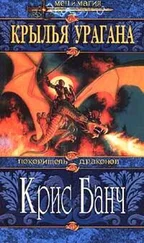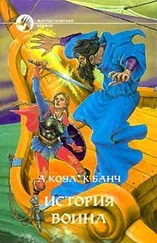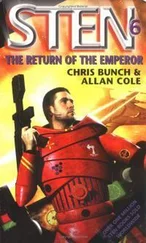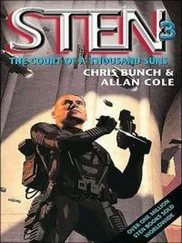"You would think, after all these years, that they could find something more original to do than just pitch us here again."
The chief IP was busily wringing out his hat and didn't answer.
Sh'aarl't, Bishop, and Sten bade leaky farewells, vowing to write, to get together once a year, and all the rest of the bushwa service people promise and never do.
Sh'aarl't was still awaiting orders. Bishop's orders were exactly what he wanted—pushing a large, unarmed transport around the sky from one unknown and therefore peaceful system to another.
Sten wondered if he would ever see either of them again.
There was no pomp and there was carefully no ceremony when Lady Atago transferred her command from the battleship Forez to the infinitely smaller Zhenya .
Admiral Deska had spent a good portion of his military career studying his superior. She despised the frills and displays of military recognition. All that she required was that one do exactly as she indicated without hesitation. She became very thoughtful about any icing upon that requirement.
Despite their size, the Zhenya and her sisterships were a major tech miracle for the Tahn. The design and development of the ships would have cost even the Imperial naval R&D staff a good percentage of its budget.
The Zhenya was intended for mine warfare of the most sophisticated kind, a type of combat that the Imperial Navy had given little attention.
It had been a very long time since the Empire had fought a war with an equal. Even the brutal Mueller Wars were, ultimately, a limited uprising. Mines were used in positional warfare to deny passage to the enemy or to provide stationary security for one's own positions. They could also be laid to interdict the enemy's own ship lanes. Mines simply hadn't seemed relevant to the navy strategists.
The other reason for the navy's lack of interest in mine warfare was its unromantic nature. A mine was a heavy clunk of metal that just sat there until something made it go bang, generally long after the minelayer had departed. Mine experts didn't wear long white scarves or get many hero medals, even though mines, in space, on land, or in water, were one of the most deadly and cost-efficient ways of destroying the enemy.
The Tahn were less interested in glamour than in any and every method of winning a war. The Zhenya was one of the keys to their future.
Sophisticated space mines, of a kind never seen before, could be laid with impossible speed by the Zhenya . Each mine was basically an atomic torpedo that was immediately alerted to any ship in its vicinity. A "friendly" ship would be transmitting on its Identification-Friend or Foe com line, and the mine would read the code and ignore that ship. An enemy ship or one not transmitting the current code to the mine would find a very different reaction. The mine—and any other mines within range—would activate and home on the enemy ship. With thousands of mines in any one field, even the most heavily armed Imperial battleship would be doomed.
The Tahn had also solved another problem. Space warfare, even one with established battle lines, was very mobile and its conditions changed rapidly. Retreating or attacking through one's own minefield could be lethal, even if the mine had identified the oncoming ship as friendly. It still was a large chunk of debris to encounter at speed. And if battle conditions changed, the minefield might have to be abandoned—it took a lot of time and caution to sweep a field and then re-lay it.
The Zhenya could retrieve and redeploy mines almost as fast as it could lay them. It was an interesting way to be able to create, define, or modify the field that the enemy would be forced to fight on—in theory.
The Zhenya-class ships had yet to be proved. In the Tahn's haste to add the ships to their combat fleets, there had been many failures—all ending with the deaths of the entire crew.
Deska was confident that all the problems with the Zhenya and her sister ships had been solved, but not so confident that he felt safe risking the Lady Atago's life. He explained this to her, and she listened with seeming interest. She thought for a moment.
"Assemble the crew," she said finally.
Although it was a small crew, gathered together they filled the Zhenya's mess hall. The Lady Atago waited quietly until everyone was available and then began to speak.
"Our task today," she said, "is to prove the worth of the Zhenya . On our success, much is dependent. You understand this, do you not?"
No one said a word. The audience barely breathed. But there was a stiffening of attention.
"Previous trials have ended in disappointment," she continued. "This is why I am with you today. If you die, I die. It is therefore required that every one of you perform his individual task to his supreme abilities."
She swept the room with her never changing eyes of absolute zero.
"It goes without saying," she hammered home, "that if there is a failure today, it would be best for any of you not to be among the few survivors."
She dropped her eyes and flicked at a crumb left on the otherwise spotless mess table in front of her. The crew was dismissed.
The drone tacship drove toward the Zhenya at full power. Between the robot and the minelayer hung a cluster of the newly developed mines. Lady Atago stood behind the mine control screen, watching closely.
"Report."
"All mines report incoming ship as friendly."
"Change the recognition code."
Sweat beaded one tech's forehead. It was at this point that the accidents had occurred. All too often, when the IFF code was changed, the mine either refused to attack a no-longer-friendly—according to the recognition code—ship or launched on every ship within range, including the minelayer.
This time the control board barely had time to report the change in status and register that the mine was reporting an enemy ship before six mine-missiles launched.
The drone tacship fired back with antiship missiles. Two of the mines were exploded.
The third mine hit the robot and tore out its hull. Less than a second later, a score more were hunting the debris. The rest made note of the kill and returned to station.
"Did the mines show any response to the drone's electronic countermeasures?" Atago asked.
The tech consulted a nearby screen. "Negative. All transmissions from the enemy were ignored once it had been identified."
The Lady Atago turned her attention from the screen to Admiral Deska. She allowed one perfect eyebrow to raise a millimeter.
"You may inform the council, Admiral," she said, "that we will begin full production."
A half hour later the flagship was once again the Forez .
Lady Atago went quietly back to her maps and battle plans.
Sten landed on Cavite, central world of the Caltor System, as a commander without a fleet.
Among the other shortcomings of the tacships was that their tiny supply holds limited their range. Their delicate engines also required far more frequent maintenance intervals than did most Imperial craft. So the four tacships that were to be Sten's command had been berthed in a freighter and now were somewhere between Soward and Cavite.
Sten made the long haul from Prime to Cavite as a liner passenger. He spent the voyage going through pictures, sketches, abstracts, and envelope projections, as besotted with his new assignment as any first lover.
Part of the time he devoted to a quick but thorough study of what was going to be his base planet. Cavite was about two-thirds the size of Prime World and sparsely settled. There was little industry on Cavite—mostly it was an agriculture-based economy, with a little fishing and lumbering. The climate was also similar to Prime—fairly temperate, with a tendency to snow a bit more than on Prime.
Читать дальше











